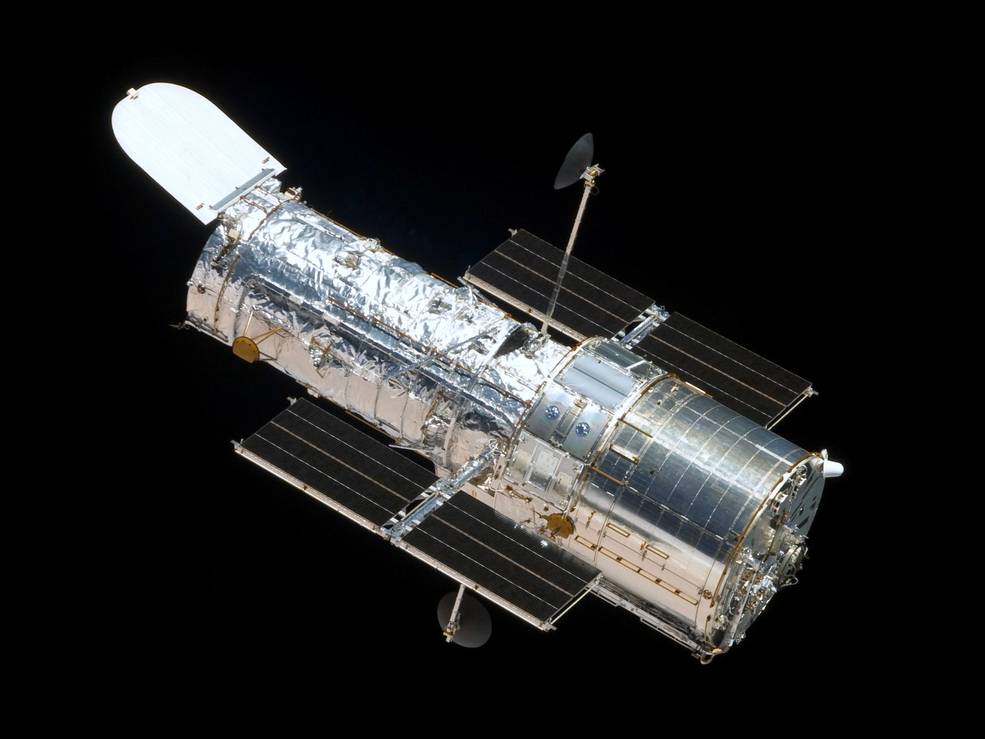Night Sky: Hubble Telescope – Looking back in time
by Dee Sharples –The relationship between time and the speed of light isn’t something most people have thought about. But when the Hubble Space Telescope was launched into orbit around the Earth on April 24, 1990, it proved to be an instrument which would allow humans to peer back in time to objects more than 13.4 billion light years from Earth. Since the observable universe is estimated to be 13.7 billion years old, that means we’re now able to see back in time almost to the Big Bang which astronomers believe to be its beginning.

Hubble’s journey to reach this point was a rocky one. After years of planning, designing and construction, the giant telescope weighing 24,000 lbs. and 43.5 feet long (the length of a large school bus) lifted off from Kennedy Space Center in Florida aboard the space shuttle Discovery. The giant telescope was a cooperative effort between NASA and the European Space Agency.
After the astronauts deployed the telescope 340 miles above Earth, it was only four weeks before astronomers discovered that the telescope’s optics were flawed, creating a blurry image.
Perkin-Elmer was the company which NASA contracted to make the perfect primary mirror required for the Hubble Telescope. It took a three-year investigation by experts to determine that the problem stemmed from an error of only 1.3 millimeters in shaping the almost 8-feet wide mirror. Interestingly, Eastman Kodak in Rochester was commissioned to make a back-up primary mirror which had been precisely tested and could have replaced the flawed mirror before launch, but the problem wasn’t discovered until after Hubble was in orbit and took its first picture.
In December 1993, astronauts aboard the space shuttle Endeavour returned to Hubble, performing five spacewalks to install a device called COSTAR, about the size of a telephone booth, to correct the flawed optics basically giving Hubble corrective lenses, like eyeglasses used to correct near-sightedness.
Now the real science began and the images taken by Hubble were breath-taking! The telescope peered at galaxies so far away from Earth, their distances had to be measured in light years. Photons of light travel at a speed of approximately 186,000 miles per second to reach our eyes – that’s a distance of almost 6 trillion (6,000,000,000,000) miles per year. Therefore, one light year equals approximately 6 trillion miles.
As an example, because the Sun is on average 93 million miles from Earth, its light takes about 8 light minutes to reach us. That means we’re actually seeing what the Sun looked like 8 minutes ago. An example frequently quoted is that if the Sun were suddenly to “go out”, we wouldn’t know about it until 8 minutes later.
The closest star to Earth, Proxima Centauri, is 4.22 light years (approximately 25 trillion miles) away. When we look at that star, we’re actually seeing what it looked like when its starlight was emitted over four years ago.
Hubble has taken pictures of infant galaxies born not long after the Big Bang. The farthest on record is a galaxy with the unassuming name of GN-z11 which we can view as it was 13.4 billion years ago, only about 400 million years after the Big Bang.
Measurements of large distances in space are determined by what’s known as “redshift” measured by spectroscopy. The greater the redshift of an object, the farther away it is. Spectroscopic observations of GN-z11 by scientists indicate that this galaxy is the farthest object ever observed.
To look back in time, see the magnificent images the Hubble Telescope has taken over the past 25 years. Check out the Hubble website at http://hubblesite.org/images/gallery.

Dee Sharples is an amateur astronomer who enjoys observing planets, star clusters and the Moon through her telescope. She is a member of ASRAS (Astronomy Section of the Rochester Academy of Science) and records “Dee’s Sky This Month”, describing what can be seen in the sky, on the ASRAS website at rochesterastronomy.org. Watch for her monthly Owl Light News feature to learn more about the night sky.